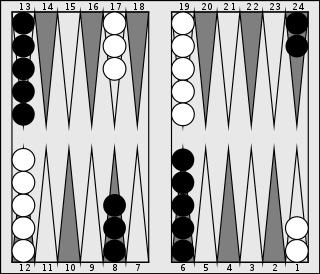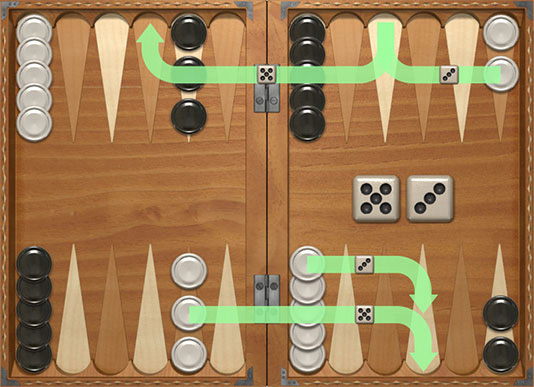| Advanced Backgammon Tips |
| by Martin Short |
| 2001 |

|
Backgammon is played for an agreed stake per point. Each game starts at one point. During the course of the game, a player who feels he has a sufficient advantage may propose doubling the stakes. He may do this only at the start of his own turn and before he has rolled the dice. Each player places 2 pieces on the 24 point, 5 pieces on the 13 point, 3 on the 8 point and 5 on the six point. Always arranged in a vertical line. The Objective of Backgammon / How to Win. The objective of the game is to bear off each of your own pieces before the opponent. Backgammon Rules Backgammon is one of the oldest known boardgames. The object of the game is to move your pieces along the board's triangles and off the board before your opponent does. There are a few different ways that this game is played. Backgammon Game Strategy Fortify your checkers in backgammon by ensuring all remain in stacks of two or more at all times. Knock opponent backgammon checkers off as much as possible. Build up your home territory with two checkers + in each spot. This makes it more difficult for the opponent to roll. Once a backgammon opponent makes an advanced anchor it is even more important to make one.
| Other articles with Backgammon Tips |
| Other articles by Martin Short |

Return to: Backgammon Galore
The Set Up

A backgammon's board consists of 24 triangles (points) that alternate colours and are grouped by six on each quarter of the board. The quarters are known as home and outer boards, opponent’s home and outer boards. In the middle of the home and outer boards, the ridge is called the “bar.”
Each point is assigned a number, starting at one on your home board (which corresponds to 24 for your opponent) and going along out and around.
To set up, you need two checkers on each players’ 24 point, five checkers on each 13 point, three checkers on point eight and five checkers on point six.
Each player rolls a dice to decide who starts. The higher number starts, moving the checkers by the value of both dices.
How To Move Checkers
Black checkers move clockwise, and white checkers move anti-clockwise around the board.
Each player rolls two dice to move around the board. Each dice can represent a different move, or the move can take into account both dice. For example, if a player rolls a six and four, one checker can move six points and another four or only one checker can move ten points. If a player rolls a double, the number is doubled. For example, a three and three means that the player has four threes to use. In this case, the player can move one, two, three or four checkers in a turn, depending on the available moves.
Moves are only allowed when the point to which a player wants to move has no more than one of the opponent’s checkers on it. The checkers move from one point to another in sequence.

If an opponent’s checker is on a point you move to, you send it to the bar in the middle. This is a hit. To bring the checker back into play, a player must roll a value corresponding to a point with no more than one of their opponent’s checker on it.
Once a player's checkers are back into play, they start from the beginning of the board again. A player cannot make moves until all their checkers are out of the bar.
How To Win!
To win the game, a player must first get all their checkers around the board and into their home board. This is when a player can start to bear off. Bearing off means removing checkers from play. To win a game a player must have borne off all their checkers.
Backgammon Instructions
To bear a checker off, a player rolls the dice value of the point on which a checker is located. If no checkers is on the point corresponding to the value rolled, a checker from the highest point number has to be moved or borne off.
If a player is hit after they have started bearing off, the checkers hit have to be moved back into play and around the board again before any other checkers can be borne off.
Backgammon Stakes

The basic aim of the game of backgammon is to bear off all your checkers, but this is only half the story. For older kids, introduce stakes and the real objective of the game: to get more stakes than your opponent.
The gambling aspect of backgammon does not have to be monetary. Stakes can be anything from sticks, candy or money. Or you can also simply keep track of stakes on a piece of paper.
How To Backgammon Board Setup
A stake is decided upfront before the game begins.
When starting, if both players roll the same value, the stake is doubled and both players roll again. This repeats until one player gets a higher number.
After the first turn, a player can offer to double the stakes before casting the dice. The other player either accepts or forfeits. Only the player who accepted can now offer to re-double.
How To Backgammon Someone
With or without stakes, the winner of the game is the player who bears off all his checkers. If the opponent has borne off at least one piece, a single game is won and the stake forfeited. A gammon is when the opponent hasn’t managed to bear off any of their checkers. This is worth double the stake. A backgammon is when the opponent has a checker left on the bar or home board: this is worth triple the stake.